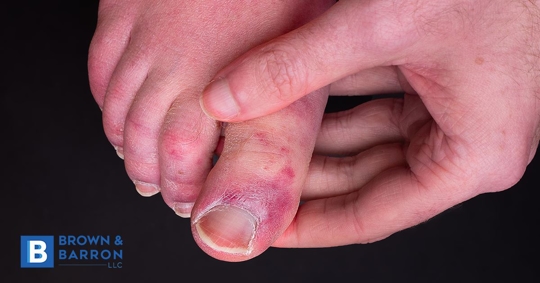Not all foot injuries are the same, and you might find yourself wondering how to determine the seriousness of an injury to you or a loved one and what you should you do. No one wants to spend a day in an emergency room for something that can be handled just as well at your local urgent care or your primary care physician’s office.
To schedule a free case review with a podiatry medical malpractice lawyer serving Baltimore, call Brown & Barron at (410) 698-1717 or contact us online today!
Remember, that every situation is unique, and you should consult a doctor for any medical advice. For educational purposes, we outline some of the conditions and injuries that podiatrists treat, and whether they could require emergency help, either from your regular doctor, a podiatrist, or an emergency room. We rank them into two categories:
Number 1: Call 911
If you have experienced an injury from a single incident you can pinpoint (e.g., something heavy dropped on your foot), this is called acute trauma. If your leg, ankle, or foot is in bad shape to the point where you cannot drive to an emergency room, and there is no one to take you, these are situations where you’ll want to dial 911 for emergency assistance:
- Compound fracture. This is where the bone is broken and has emerged through the skin. It also describes a wound so deep that the bone is exposed, according to Johns Hopkins.
- Dislocation. When the leg, ankle, or foot is pointing in an abnormal direction either at the joint or at a section of bone.
- Heavy bleeding. When there has been significant blood loss, or your injury is bleeding, and it won’t stop within a few minutes with direct pressure.
- Deep cuts. When the cut is so deep you can see yellow fatty tissue or bone.
- Sudden Numbness & Swelling. This can be associated with many foot issues, but after a single incident, it can be a symptom of compartment syndrome or deep vein thrombosis (DVT), which is a blood clot that can lead to a stroke. Seek immediate help if you or your loved one experiences “shortness of breath, chest pain, coughing, sweating or fast breath,” as this can be a sign of a DVT-related blood clot.
Number 2: Go to the Emergency Room
If you experienced an injury that is mysterious in nature, like one that develops immediately but for no particular reason, or one that has gradually gotten worse over time, these conditions warrant a prompt trip to the emergency room.
- Flesh turning blue or black. When parts of your leg, ankle, foot, or toes start turning dark blue or black without an acute trauma, it could mean a blockage of blood flow to the area (called ischemia). Ischemia can be the warning sign of gangrene setting in, which can lead to amputation, if the blood flow is not restored.
- Sudden loss of function. If there was no acute trauma, but you find that you cannot move your leg, ankle, foot, or toes, it can mean a nervous system issue or a tendon rupture.
- Gradual Numbness & Swelling. If your leg, ankle, foot, or toes become numb and there is swelling, it can be the sign of chronic compartment syndrome or DVT.
- A spreading rash. If you notice expanding areas of redness or red streaks on your ankle, foot, or toes on one side, it could be cellulitis. It may also occur with pain or swelling. If untreated it can spread to the lymph nodes, creating a potentially life-threatening condition. If it’s accompanied with a fever, get to an emergency room.
When Does a Bad Podiatry Experience Become Malpractice?
In the vast majority of podiatry experiences, the patient gets relief of discomfort or treatment for potentially dangerous conditions of the legs, ankles, and feet from a compassionate and professional healthcare professional with specialized expertise in this area of the body. In rare cases, the podiatrist will recommend an unconventional surgical option, make an inexcusable error during treatment, or fail to diagnose a serious issue, or commit some other wrongful act of abuse or negligence, leaving the patient with increased pain, loss of function, amputation, or worse.
Many times, the podiatrist’s missteps require extensive treatments, retreatments, surgeries, and rehab, which can cost the patient thousands upon thousands of dollars. It can also mean extensive suffering, permanent disfigurement, loss of function, loss of quality of life, and the loss of the ability to work.
To schedule a free case review with a podiatry medical malpractice lawyer serving Baltimore, call Brown & Barron at (410) 698-1717 or contact us online today!
If you are the victim of a podiatry experience that has left you with a significant injury, you need a legal professional to help you examine your case to determine if malpractice occurred, collect the necessary evidence, review that evidence with medical experts in podiatry, and secure a fair financial settlement through negotiation or trial. There is no out-of-pocket expense, as the law firm is paid only if you win, from a percentage of the financial settlement or verdict. There is a time limit to make a claim for a podiatry injury, so it is important to contact an attorney immediately. For a law firm with expertise in podiatry malpractice cases in Baltimore, the state of Maryland, and Washington, D.C., contact Brown & Barron at: 410-346-0206 or by contacting us online. The consultation is free.


